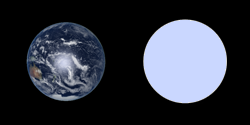WD 2359-434 (Gliese 915, LHS 1005, L 362-81) is a nearby degenerate star (white dwarf) of spectral class DAP5.8,[4] the single known component of the system, located in the constellation Phoenix, the nearest star in this constellation.
| Observation data Epoch J2000[1] Equinox J2000[1] | |
|---|---|
| Constellation | Phoenix |
| Right ascension | 00h 02m 10.72420s[2] |
| Declination | −43° 09′ 55.3906″[2] |
| Apparent magnitude (V) | 12.76[3] |
| Characteristics | |
| Spectral type | DAP5.8[4] |
| Apparent magnitude (B) | 13.12[1] |
| Apparent magnitude (V) | 12.76[3] |
| Apparent magnitude (RKC) | 12.82[5] |
| Apparent magnitude (IKC) | 12.66[5] |
| Apparent magnitude (J) | 12.60 ± 0.03[5] |
| Apparent magnitude (H) | 12.43 ± 0.02[5] |
| Apparent magnitude (KS) | 12.45 ± 0.02[5] |
| Astrometry | |
| Radial velocity (Rv) | -58.8 ± 10.8[6] km/s |
| Proper motion (μ) | RA: 613.785 mas/yr[2] Dec.: -686.989 mas/yr[2] |
| Parallax (π) | 120.0143 ± 0.0215 mas[2] |
| Distance | 27.176 ± 0.005 ly (8.332 ± 0.001 pc) |
| Absolute magnitude (MV) | 13.20[3][5][note 1] |
| Details | |
| Mass | 0.85 ± 0.01[5] M☉ |
| Radius | 0.0097[5][note 2] R☉ |
| Surface gravity (log g) | 8.39 ± 0.01[5] cgs |
| Temperature | 8570 ± 50[3] K |
| Age | 1.82 ± 0.06[5][note 3] Gyr |
| Other designations | |
| Database references | |
| SIMBAD | data |
Location of WD 2359−434 in the constellation Phoenix | |
Distance
editCurrently, the most accurate distance estimate of WD 2359−434 is a trigonometric parallax from Gaia DR3:[2] 120.0143±0.0215 mas, corresponding to a distance of 8.332±0.001 pc, or 27.176±0.005 ly. WD 2359−434 is the 13th closest white dwarf to the Sun.[7]
Physical parameters
editWD 2359−434's mass is 0.85 ± 0.01 Solar masses,[5] its surface gravity is 108.39 ± 0.01 (2.45 · 108) cm·s−2,[5] or approximately 250,000 of Earth's, corresponding to a radius 6780 km, or 1.06 of Earth's.
WD 2359−434 is relatively hot and young white dwarf, its temperature is 8570 ± 50 K;[3] its cooling age, i. e. age as degenerate star (not including lifetime as main sequence star and as giant star) is 1.82 ± 0.06 Gyr.[5] Gliese 518 should appear bluish-white, due temperature, comparable with that of A-type main sequence stars.
As all white dwarfs, WD 2359−434 is composed of very dense degenerate matter, its mean density is 1,300,000 g·cm−3,[5][note 4] i.e. mass of one cubic millimetre of WD 2359−434 matter is 1.3 kg.
Unusually for a white dwarf star, WD 2359-434 has a weak, non-dipole magnetic field of 50,000 - 100,000 Gauss.[8]
Main sequence progenitor properties
editAs all degenerate stars, WD 2359−434 previously existed initially as main-sequence star and then as giant star, until all the thermonuclear fuel was exhausted, after which WD 2359−434 lost most of its mass. According to the 2010 thesis for the degree of Doctor of Science,[9] using Wood model D[10] initial–final mass relation and WD 2359−434's white dwarf mass value 0.97 ± 0.03 M☉ from Holberg et al. 2008,[3] its main sequence progenitor mass was 7.09 M☉. Using expression for pre-white dwarf lifetime 10 · (MMS/M☉)2.5 (Gyr),[10] was found WD 2359−434 main sequence age 0.07 Gyr.
White dwarf mass value 0.85 ± 0.01 M☉ from Subasavage et al. 2009,[5] in Wood model D yields MS (main sequence) mass 6.03 M☉, and MS lifetime 0.11 Gyr, corresponding to B-type main sequence star.
According to initial-final mass relation from Weidemann 2000 paper,[11] WD 2359−434's main sequence progenitor should have mass about 4.6 M☉ and lifespan 0.22 Gyr, and, again, should be of B spectral type. There are also other models.
See also
editNotes
editReferences
edit- ^ a b c d "GJ 915 -- White Dwarf". Centre de Données astronomiques de Strasbourg. Retrieved 2011-11-03.
- ^ a b c d e Vallenari, A.; et al. (Gaia collaboration) (2023). "Gaia Data Release 3. Summary of the content and survey properties". Astronomy and Astrophysics. 674: A1. arXiv:2208.00211. Bibcode:2023A&A...674A...1G. doi:10.1051/0004-6361/202243940. S2CID 244398875. Gaia DR3 record for this source at VizieR.
- ^ a b c d e f Holberg, J. B.; Sion; Oswalt; McCook; Foran; Subasavage (2008). "A New Look at the Local White Dwarf Population". The Astronomical Journal. 135 (4): 1225–1238. Bibcode:2008AJ....135.1225H. doi:10.1088/0004-6256/135/4/1225. S2CID 122855486.
- ^ a b Sion, Edward M.; Holberg; Oswalt; McCook; Wasatonic (2009). "The White Dwarfs within 20 Parsecs of the Sun: Kinematics and Statistics". The Astronomical Journal. 138 (6): 1681–1689. arXiv:0910.1288. Bibcode:2009AJ....138.1681S. doi:10.1088/0004-6256/138/6/1681. S2CID 119284418.
- ^ a b c d e f g h i j k l m n o Subasavage, John P.; Jao; Henry; Bergeron; Dufour; Ianna; Costa; Mendez (2009). "THE SOLAR NEIGHBORHOOD. XXI. PARALLAX RESULTS FROM THE CTIOPI 0.9 m PROGRAM: 20 NEW MEMBERS OF THE 25 PARSEC WHITE DWARF SAMPLE". The Astronomical Journal. 137 (6): 4547–4560. arXiv:0902.0627. doi:10.1088/0004-6256/137/6/4547. S2CID 14696597.
- ^ Pauli, E.-M.; Napiwotzki; Heber; Altmann & Odenkirchen (2006). "3D kinematics of white dwarfs from the SPY project. II". Astronomy and Astrophysics. 447 (1): 173–184. arXiv:astro-ph/0510494. Bibcode:2006A&A...447..173P. doi:10.1051/0004-6361:20052730. S2CID 14250519. (see Table 8)
- ^ Reylé, Céline; Jardine, Kevin; Fouqué, Pascal; Caballero, Jose A.; Smart, Richard L.; Sozzetti, Alessandro (30 April 2021). "The 10 parsec sample in the Gaia era". Astronomy & Astrophysics. 650: A201. arXiv:2104.14972. Bibcode:2021A&A...650A.201R. doi:10.1051/0004-6361/202140985. S2CID 233476431. Data available at https://gruze.org/10pc/ Archived 12 March 2023 at the Wayback Machine
- ^ Landstreet, J. D.; Bagnulo, S.; Valyavin, G.; Valeev, A. F. (2017), "Monitoring and modelling of white dwarfs with extremely weak magnetic fields", Astronomy & Astrophysics, 607: A92, arXiv:1709.04099, doi:10.1051/0004-6361/201731432, S2CID 119502643
- ^ Matías Cristóbal Radiszcz Sotomayor, BINARIEDAD ESTELAR Y SUB-ESTELAR EN ENANAS BLANCAS CERCANAS[permanent dead link]
- ^ a b Wood, M. A. (1992). "Constraints on the age and evolution of the Galaxy from the white dwarf luminosity function". The Astrophysical Journal. 386: 539–561. Bibcode:1992ApJ...386..539W. doi:10.1086/171038.
- ^ Weidemann, V. (2000). "Revision of the initial-to-final mass relation". Astronomy and Astrophysics. 363: 647–656. Bibcode:2000A&A...363..647W.

